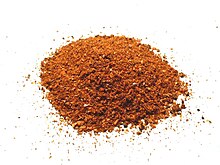Aleppo pepper
| Aleppo pepper | |
|---|---|
 Aleppo pepper, in its typical processed form. | |
| Species | Capsicum annuum |
| Origin | Aleppo, Syria |
| Heat | |
| Scoville scale | 10,000 SHU |
The Aleppo pepper (Arabic: فلفل حلبي / ALA-LC: fulful Ḥalabī) is a variety of Capsicum annuum used as a spice, particularly in Middle Eastern, and Mediterranean cuisine. Also known as the Halaby pepper,[1] it starts as pods, which ripen to a burgundy color, and then are semi-dried, de-seeded, then crushed or coarsely ground.[2] The pepper flakes are known in Turkey as pul biber (pul = flake, biber = pepper), and in Armenia as Haleb biber. In Turkey, pul biber is the third most commonly used spice, after salt and black pepper. In Arabic, the pepper is named after Aleppo, a long-inhabited city along the Silk Road in northern Syria, and is grown in Syria and Turkey.
Although a common condiment, its use in Europe and the United States outside Armenian, Syrian and Turkish immigrant communities was rare until the 20th century, with one source (Los Angeles magazine) dating its rise in use among the broader U.S. population according to the 1994 publication of The Cooking of the Eastern Mediterranean (ISBN 978-0-06-016651-9) by Paula Wolfert.[3]
Characteristics
The Aleppo pepper has a moderate heat level of about 10,000 on the Scoville scale,[4][5] with some fruitiness and mild, cumin-like undertones. Its flavor is similar to the ancho chile, but oilier and slightly salty; salt is often used in the drying process.[2] It is fairly mild, with its heat building slowly, with a fruity, raisin-like flavor. It has also been described as having the flavor of "sweetness, roundness and perfume of the best kind of sundried tomatoes, but with a substantial kick behind it."[6] Some renowned chefs prefer Aleppo pepper for its "fruity and bright qualities."[7]
Uses
The most common use is in the form of crushed flakes, which are typically slightly milder and oilier than conventional crushed red pepper, with a hint of saltiness and a slightly raisin-like flavor. Unlike crushed red pepper, the flakes contain no inner flesh or seeds, contributing to the mildness. Crushed Aleppo pepper can be used as a substitute for crushed red pepper or paprika.
The spice is a common ingredient in some of the dishes that comprise a meze.[8]
See also
References
- ^ "Chiles You Haven't Heard of but Soon Will". www.spicesinc.com. Retrieved 2018-08-28.
- ^ a b David Floyd (June 10, 2010). "The Aleppo Pepper". United Kingdom: The ChileFoundry. Retrieved 2010-10-20.
- ^ "Hot Stuff". Connoisseur Corner. Los Angeles. May 2002. Archived from the original on 2010-02-27. Retrieved 2010-10-20.
- ^ "Aleppo Pepper: Silk Roads and Subpar Steaks". Spice World (blog). Riverfront Times. July 27, 2010. Archived from the original on 2010-10-01. Retrieved 2010-10-20.
- ^ "Pepper Heat Ratings in Scoville Units". Penzeys Spices. Archived from the original on 2010-02-27. Retrieved 2010-10-20.
- ^ "Bluefish and Aleppo Pepper". Diner's Journal (blog). The New York Times. June 27, 2008. Retrieved 2010-10-20.
- ^ "How Syria's Famous Aleppo Pepper Might Be Saved". National Geographic. 2016-04-05. Retrieved 2020-10-04.
- ^ "Bank holiday special: A picnic with a twist". Metro. 27 April 2009. Retrieved 2010-10-20.
